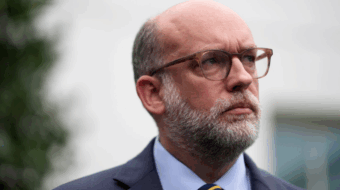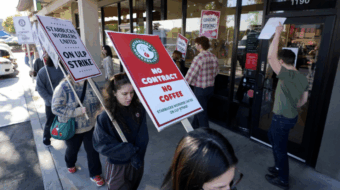
NEW YORK CITY — In 2001, New York State Supreme Court Justice Leland DeGrasse ruled that New York State was in violation of its own Constitution which guarantees every child the right to a “sound, basic education.” DeGrasse wrote a landmark decision in favor of the Campaign for Fiscal Equity’s argument that New York City public schools were unconstitutionally underfunded.
Since then, education activists, teachers and parents have been fighting — in the courts and in the court of public opinion — to remedy the gross inequities in public school funding.
DeGrasse’s ruling has been affirmed at many different levels of the court system, but the years have passed and New York City’s public school students continue to be cheated. (Although the CFE case was filed on behalf of New York City’s schools, the courts’ decisions will affect school funding statewide, and ultimately should result in more money going to many other underfunded districts around the state.)
This struggle, initiated in 1993, took another step forward last month at a hearing before the state Court of Appeals. In a nutshell, the case is down to this: Do the courts have the right to require the legislature to allocate funds for a specific purpose? If the Campaign for Fiscal Equity (CFE) wins, the city’s public school students would be in for a windfall — perhaps as much as $5 billion a year.
Big city, big school system, big problems
One-third of all school children in New York State live in New York City. New York City is the largest school system in the country. It also has some of the biggest problems and challenges, among them that 80 percent of students have limited English proficiency and 62 percent live in poverty.
A 2005 Education Trust report showed that the city’s school children are victims of the biggest funding gap in the nation. And there is a direct correlation between per pupil spending and graduation rates. Only 50 percent of students graduate, the third lowest of all urban school districts in the country.
Although some schools shine, many are troubled places, with inadequate and dilapidated facilities, out-of-date equipment, and teachers and staff who are overwhelmed with large classes, burdensome requirements from N.Y.’s Department of Education, and growing pressure to “teach to the test” (standardized test prepping).
More bleak statistics: 29 percent of elementary schools have instruction in hallways, gyms and other converted space; 21 percent of high schools and 33 percent of middle schools have no functioning science lab; 32 percent of elementary schools have no playground.
Special education services are a huge issue. Recently the office of the city’s Public Advocate received information that hundreds of special education classrooms are over capacity — some at close to double capacity. Scores of special education students are currently sitting at home “awaiting placement.”
Long legal battle
In an interview with the World, April Humphrey, NYC lead organizer for the Alliance for Quality Education, the coalition that organizes grassroots support for the CFE case, described the dense legal maze it has gone through as ruling after ruling was appealed by Republican Gov. George Pataki.
“In 2002, the Court of Appeals affirmed the trial court decision and ordered New York State to come up with the money to fully fund NYC’s schools. Both CFE and Pataki did costing out studies, but came up with wildly diverging figures.” (CFE, $6 billion annually; Pataki’s commission, $2 billion.)
No money was ever allocated, however, since the State Assembly and State Senate didn’t agree on the governor’s figure, and when the judge’s 13-month deadline came and went, the court set up a “Special Masters” panel.
“This panel calculated the cost at $5.6 billion, pretty close to the CFE figure,” Humphrey said. “After another appeal, the state Supreme Court affirmed both the amount and the process. And then, again, this was appealed by Pataki to the Appellate Division court, which said the dollar figure was about right, but that, on the other hand, the courts don’t have the power to compel the Legislature to come up with money. So this decision was appealed by both sides.”
Where will the money come from?
Once the legal battle is settled, the 800-pound gorilla in the room — where will the money come from — will move front and center. This also has wide implications for school districts across the country fighting similar fair funding battles.
A recent article in the Wall Street Journal claimed the cost of implementing CFE was too high, and would place a huge burden on homeowners in new property taxes.
Republican gubernatorial candidate John Faso argued that more money isn’t needed, and that the state can’t afford it. And although Democratic Governor-elect Eliot Spitzer has promised to settle the case and has received the support of the teachers union, one of his proposals for a funding source — lowering health care costs by closing hospitals — goes in the wrong direction and is certain to be fought by many of the same forces that support CFE.
CFE and AQE have long argued that finding ways to fund programs is the job of the state Legislature, but as Humphrey noted, “they had 13 months and didn’t come up with anything.” She added, “AQE does not advocate raising this money through higher property taxes.”
According to the Fiscal Policy Institute, “What New York State needs to do now is to undo some of the damage of the last 25 years. It needs to move in the opposite direction to make the tax system fairer and to generate the revenue necessary to fund a statewide solution to the Campaign for Fiscal Equity lawsuit and to reduce the pressure that we are now placing on the property and sales tax bases.”
Humphrey agrees: “What we need is to go back to an income tax structure more similar to what existed in the late 1970s, before Pataki cut taxes for the highest income earners. This would raise a huge amount of money.
“If previous state income tax levels were restored, the fact is that lots of localities would be able to reduce property taxes. New York State provides one of the lowest levels of school funding in the country, and relies much more heavily on local taxes, which for the most part means property taxes. We actually are advocating that the state raise the overall level of funding but also that it take on a bigger share of the total so localities can reduce their share.
“In addition, other proposals have been put out, like the idea of closing the corporate tax loopholes.”
When asked about what these billions could buy, Humphrey explained, “Justice DeGrasse used concrete measures in making his [original] ruling. He looked at three things: class size, teacher quality and what are called ‘instrumentalities of learning,’ that is, equipment and supplies.
“So some of the money would go to reducing class sizes. Class size makes a big difference in test performance, grades, etc. Nobody would argue that NYC class sizes aren’t too big. It’s just the hard cold truth.”
Big issue: smaller class size
Class size is considered one of the single most important factors in providing children with the best learning environment, and classes in New York City are way above the state average. This issue has been the focus of many campaigns in recent years, in addition to the CFE case.
In 2005, the Working Families Party initiated a campaign to fund class size reduction by maintaining an existing tax surcharge on incomes over $500,000. (See related charts.)
That same year, the advocacy group New Yorkers for Smaller Class Sizes collected tens of thousands of signatures to place on the ballot a referendum requiring immediate reduction of class sizes. Perhaps taking a page from Pataki, Mayor Michael Bloomberg blocked the referendum and then appealed it in court, and that battle is still taking place.
Referring to another of Judge DeGrasse’s criteria, teacher quality, Humphrey explained the effect of more funding: “Well, one measure is turnover, which is much higher in NYC. We end up with a lot of inexperienced teachers, and then they end up concentrated in the worst performing schools, and then there are other problems. There’s no mentoring available; it’s hard to gain the experience you need.
“Fifty percent of New York City’s new teachers leave within their first five years of teaching, either for other school districts or out of the profession altogether,” Humphrey said. “And if you survey those who leave, their reasons are class size, salary, and lack of respect and autonomy on the job.”
What’s ahead
A decision on the October court hearing could take from three to six months, and should settle three issues, said Humphrey. “One, do the courts have the right to tell the executive and legislative branches what to do and where to spend money, two, how much money is required to meet the state’s constitutional standard and three, what kind of accountability measures must be included.”
CFE is hoping the court will agree with them that it “can order the state to allocate funds, that it is completely within the authority of the court because the state’s Constitution is being violated.”
While awaiting the court decision, education funding activists will not be sitting still. “We’re hopeful about the state elections, because [Democratic gubernatorial candidate] Spitzer has already said that, assuming he’s elected, resolving CFE on a statewide basis is one of his top priorities,” Humphrey said. “He sounds much more positive than Pataki.” Meanwhile AQE plans to continue building its grassroots campaign. And as New York City Councilman Robert Jackson, the lead plaintiff in the CFE lawsuit, puts it, “we’re not giving up until all of our children receive their constitutionally mandated right to a ‘sound basic education.’”
Elena Mora (emora@cpusa.org) is chair of the New York State Communist Party.









